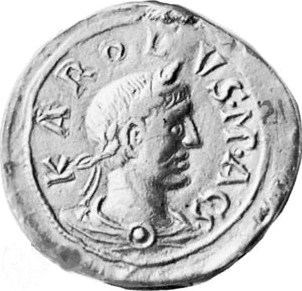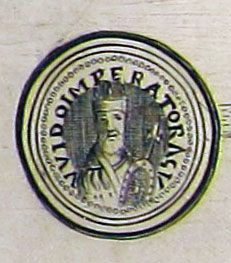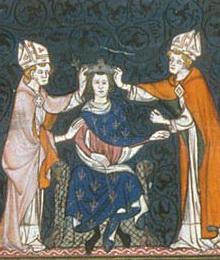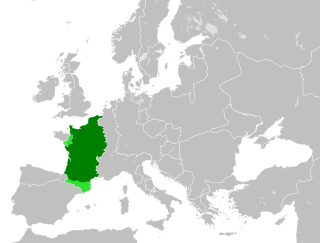Biography
The death of bishop Geilo of Langres on 28 June 888 came shortly after the death of the Emperor Charles III. The resulting election of the bishop's successor thus took place while the thrones of the various kingdoms of the empire were themselves in dispute. Following his canonical and popular election, Argrim was consecrated bishop by archbishop Aurelian of Lyon, but archbishop Fulk of Reims, who supported the claim of Charles the Simple to the throne, tried to force Theutbald on the church of Langres instead. He convinced Pope Stephen V to back him, and the pope wrote two letters to Aurelian to pressure him to consecrate Theutbald and withdraw his support from Argrim. It took two years and three months for Theutbald's party to gain the upper hand and remove Argrim from Langres. In the autumn of 890, at Pope Stephen's instruction, Theutbald was brought to Langres by Fulk and consecrated bishop.
Argrim was one of the rival bishops of Langres following the disputed election of 888. He was the uncontested bishop after 899 until his retirement in 910. Before becoming bishop he was a monk of Saint-Bénigne de Dijon.

Pope Stephen V was Pope from September 885 to his death in 891. He succeeded Pope Adrian III, and was in turn succeeded by Pope Formosus. In his dealings with Constantinople in the matter of Photius, as also in his relations with the young Slavic Orthodox church, he pursued the policy of Pope Nicholas I.
In 894 Theutbald sent a delegation to the council of Chalon-sur-Saône. Late in 894, his enemies, led by Duke Richard of Burgundy, attacked him and gouged out his eyes. As a result, the temporalities which the bishops had possessed in and around the city of Langres since the time of the Emperor Louis the Pious passed to the duke of Burgundy, since the king of West Francia at the time, Odo, was too weak to intervene and had in 889 favoured Argrim. He died as a result of the procedure, and Argrim was restored.

Chalon-sur-Saône is a commune in the Saône-et-Loire department in the region of Bourgogne-Franche-Comté in eastern France.

Langres is a commune in northeastern France. It is a subprefecture of the department of Haute-Marne, in the region of Grand Est.

Louis the Pious, also called the Fair, and the Debonaire, was the King of the Franks and co-Emperor with his father, Charlemagne, from 813. He was also King of Aquitaine from 781.

Hugh Capet was the King of the Franks from 987 to 996. He is the founder and first king from the House of Capet. He was elected as the successor of the last Carolingian king, Louis V. Hugh was a descendant in illegitimate descent of Charlemagne through his paternal grandmother.

Robert I of France was the elected King of West Francia from 922 to 923. Before his election to the throne he was Count of Poitiers, Count of Paris and Marquis of Neustria and Orléans. He succeeded the overthrown Carolingian king Charles the Simple, who in 898 had succeeded Robert's brother, king Odo.

Charles III, also known as Charles the Fat, was the Carolingian Emperor from 881 to 888. The youngest son of Louis the German and Hemma, Charles was a great-grandson of Charlemagne. He was the second-to-last emperor of the Carolingian dynasty and the last to rule, briefly, over a re-united Frankish empire.
Hincmar, archbishop of Reims, was the friend, advisor and propagandist of Charles the Bald. He belonged to a noble family of northern Francia.

The Roman Catholic Archdiocese of Reims is an archdiocese of the Latin Rite of the Roman Catholic Church in France. Erected as a diocese around 250 by St. Sixtus, the diocese was elevated to an archdiocese around 750. The archbishop received the title "primate of Gallia Belgica" in 1089.

Guy of Spoleto, sometimes known by the Italian version of his name, Guido, or by the German version, Wido, was the Margrave of Camerino from 880 and then Duke of Spoleto and Camerino from 883. He was crowned King of Italy in 889 and Holy Roman Emperor in 891. He died in 894 while fighting for control of the Italian Peninsula.
Fulk the Venerable was the Archbishop of Reims from 883 until his death. He was the chief opponent of the non-Carolingian king of France, Odo, in the last quarter of the 9th century. He was the brother of Anscar I, Margrave of Ivrea
Odo I, Count of Blois, Chartres, Reims, Provins, Châteaudun, and Omois, was the son of Theobald I of Blois and Luitgard, daughter of Herbert II of Vermandois. He received the title of count palatine, which was traditional in his family, from King Lothair of West Francia.

The Roman Catholic Diocese of Langres is a Roman Catholic diocese comprising the département of Haute-Marne in France.
The March of Ivrea was a large frontier county in the northwest of the medieval Italian kingdom from the late 9th to the early 11th century. Its capital was Ivrea in present-day Piedmont, and it was held by a Burgundian family of margraves called the Anscarids. The march was the primary frontier between Italy and France and served as a defense against any interference from that state.
Geilo was the Bishop of Langres from 880 until his death. His episcopate coincided mostly with the emperorship of Charles the Fat and after 885 he is a leading ecclesiastical figure at the imperial court. Geilo increased the landholdings and comital rights of the diocese of Langres immensely in his short tenure, a sign of political sagacity. Geilo has been painted as a villain, an ambitious prelate trying to extend his see's temporal authority as far as it could go under the reign of weak Carolingians.

The Roman Catholic Archdiocese of Dijon is a diocese of the Latin Rite of the Roman Catholic Church in France. The archepiscopal see is Dijon Cathedral, which is located in the city of Dijon. The diocese comprises the entire department of Côte-d'Or, in the Region of Bourgogne. Originally established as the Diocese of Dijon in 1731, and suffragan to the Archdiocese of Lyon, the diocese was elevated to the rank of archdiocese in 2002. The most significant jurisdiction change occurred after the Concordat of 1801, when the diocese annexed the department of Haute-Marne. In 1821, a Papal Bull re-established the Diocese of Langres. The current archbishop is Roland Minnerath, appointed in 2004.

The accession of the King of France was legitimized by coronation ceremony performed with the Crown of Charlemagne at Notre-Dame de Reims. However, the person did not need to be crowned in order to be recognized as French monarch; the new king ascended the throne when the coffin of the previous monarch descended into the vault at Saint Denis Basilica, and the Duke of Uzès proclaimed "Le Roi est mort, vive le Roi"!

Louis the Stammerer was the King of Aquitaine and later the King of West Francia. He was the eldest son of emperor Charles the Bald and Ermentrude of Orléans. Louis the Stammerer was physically weak and outlived his father by only two years.

The Lateran Council of 769 was a synod held in the Basilica of St. John Lateran to rectify perceived abuses in the papal electoral process which had led to the elevation of the Antipopes Constantine II and Philip. It also condemned the rulings of the Council of Hieria. It is perhaps the most important Roman council held during the 8th century.
Theutbald I was the bishop of Langres from when he was elected to succeed Alberic until his death. He is first securely attested as bishop in 842. He may have belonged to the same Bavarian family that had dominated the episcopate of Langres since 769.
Hervé de Reims was a 10th century Bishop of France who was the son of Ursus, Count of Champagne. He was consecrated on 6 July 900 by Riculfus, Bishop of Soissons. He consecrated King Robert I of France at Saint-Remi in Reims.

















